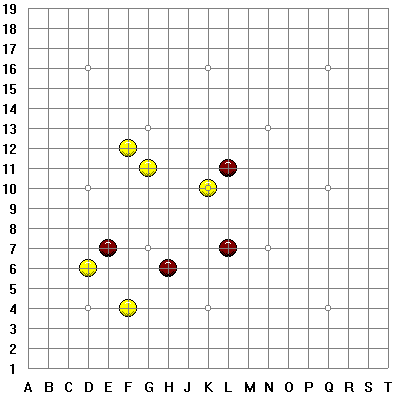
Scott Justice's puzzling look at Pente®
Ninthlife EASY
No Snakes SOSO
Teshera HARD!
Quincunx HARD!!
I wrote this problem to help illustrate the basic ideas behind pente puzzles. Although I consider it pretty easy, it still is tricky. Spend a couple of minutes right now to figure it out. If you are stumped after that, then read on for some hints that hopefully illustrate the basic principles behind pente puzzles.
Ninth Life
August 2002. Scott Justice.
Pente in 5.
Captures:
White (yellow) has 4.
Black (brown)has 0.

1. White always moves first and must win in the stipulated number of moves, even against the most stubborn defense. In this problem, white must actually have five captures or five-in-a-row by his fifth move. That means black will only have four moves to defend.
2. All stones in the puzzle must be essential for the problem to work. In other words, the author can't just throw some extra stones on the board merely to muddy it up for you. A good problem may have several misleading lines of play, but each stone still must have a bearing on the solution. Some stones will play a direct role in the winning combination, while others may block white from having more than one way to win. In "Ninth Life", ask yourself what role the stones on D6 and F4 play.
3. The number of captures that have been taken are stated and often affect the solution. In fact, your first hint in solving a puzzle is how many captures are listed. Once again, a pente problem creator cannot try to mislead you by stating an arbitrary number. In this case, white needs one more capture to win. The stones on D6 and F4 are not there to become part of a five-in-a-row, but to force the fifth capture. In the problem "No Snakes", neither side has any captures. Also, there are no black stones on the board and white must win in 6 moves. Therefore, it is obvious that the only way for white to solve the problem is with a five-in-a-row since there is no way to capture 10 black stones in just 6 moves. That's an obvious example, but the point is that captures matter and are clearly stated with each problem.
4. Be aware of black's offensive capability. In Ninth Life, white has to force five captures or five-in-a-row without letting black get any offense going. The stones at L7 and L11 can stall white if black gets a chance to play in between them. So, white does not have the luxury of making a quiet set up move. He has to force black's response right away.
5. The first move is usually something you would not initially think of playing. I know you are saying, "Duh!" But, look at the puzzle. From what we've learned from the above points, white has 5 moves to force a capture, the stones down on D6 and F4 are there to capture, the black stones on E7 and H6 appear to be there in relation D6 and F4, and white's first move is unexpected but forceful enough to nullify black's possible offensive ability along the L file. Could white be trying to force black to play his fourth move at F8 or G5?
Try the puzzle again if you did not solve it the first time. When you think you've gotten it, check the solution.